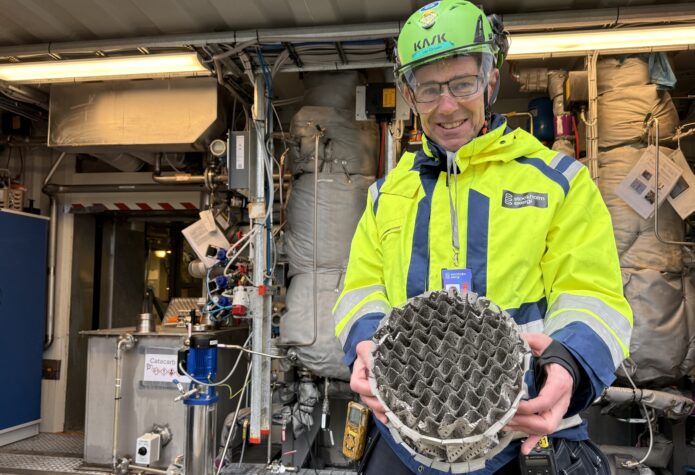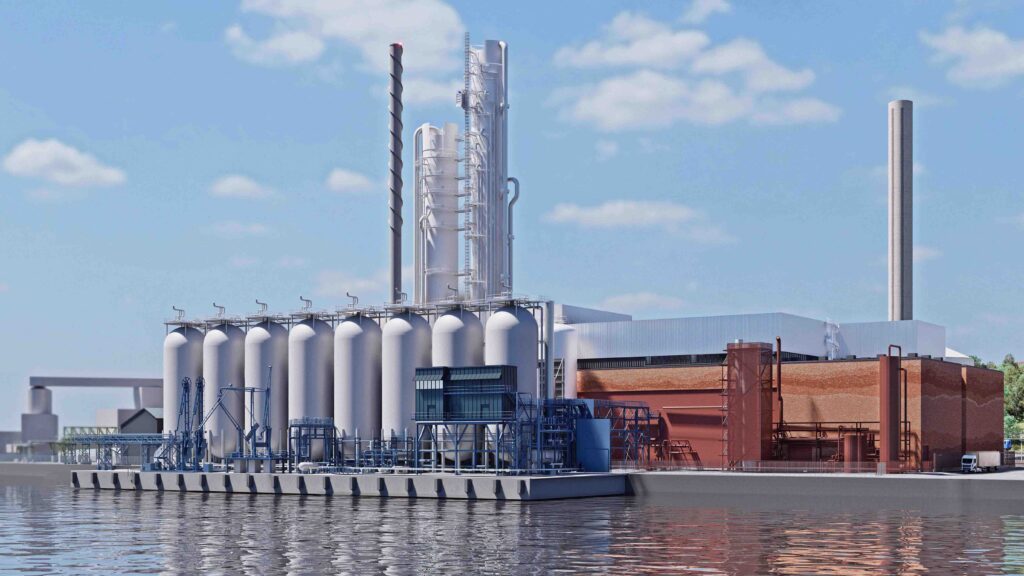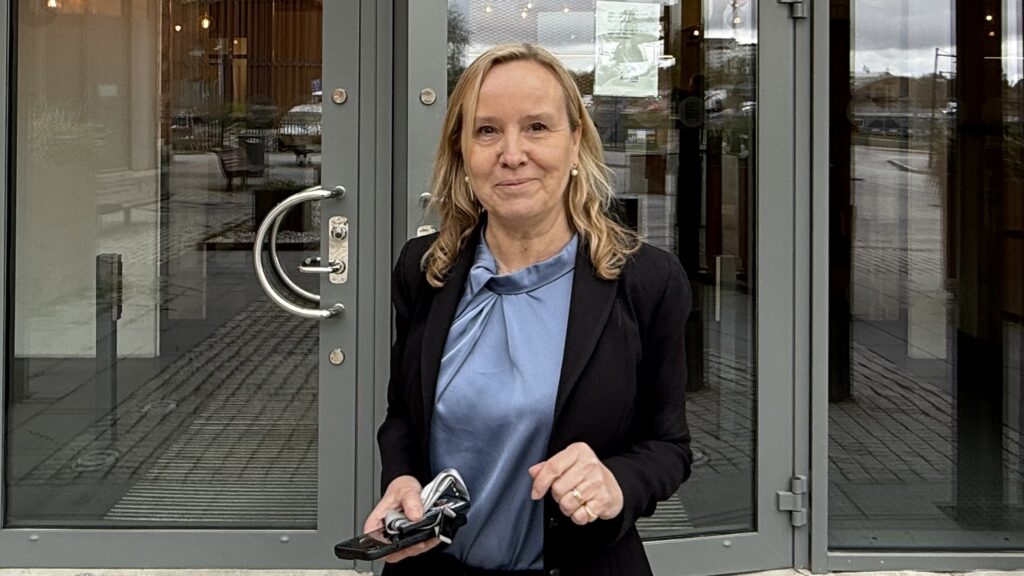Stockholm Exergi: Where carbon turns to stone

“Cutting emissions is no longer enough to meet climate goals—we must also remove carbon dioxide. Our carbon capture and permanent storage project will become an entirely new line of business, making Stockholm one of the first cities in the world to do this at scale,” says Åse Lagerqvist von Uthmann, CFO of Stockholm Exergi. “It’s a big step, and one we hope others will build on.”
By Arild Moen, Associate Director, Communication at NIB
A fine drizzle lingers over Stockholm as I arrive at the Värtan combined heat and power plant, where the ancient oaks are in bud and spring is well under way. But the air here carries more than mist. It carries the weight of ambition—Stockholm Exergi is building a facility that could reshape how cities cut carbon emissions.
Negative emissions
Stockholm Exergi—the largest provider of district heating in the Stockholm region—is building a carbon capture facility to remove and permanently store 800,000 tonnes of biogenic CO₂ under the North Sea seabed annually. That’s more than the total emissions from road traffic in Stockholm during the same period.
The carbon dioxide will be permanently stored more than 800 metres below the seabed of the North Sea, in sedimentary rock off the coast of Norway.
In its first ten years, the bio-energy carbon capture and storage (BECCS) facility is expected to remove approximately 7.83 million tonnes of CO₂ equivalents.
Biogenic refers to CO₂ from living sources like biomass. Its capture and storage permanently remove carbon that would otherwise re-enter the atmosphere, thereby generating negative emissions.
The Stockholm BECCS includes facilities for CO₂ compression, liquefaction and the reconstruction of an existing quay to support intermediate storage operations and shipping when the facility starts operations late in 2028.

Stockholm Exergi is owned equally by the City of Stockholm and Ankhiale, a consortium of European pension funds consisting of APG, Alecta, PGGM, Keva, and AXA.
Combined heat and power
I first visited Värtan in 2016, when Stockholm inaugurated its biofuel-fired combined power and heat plant. It was a milestone in the city’s green energy transition—the plant engineered with inswings to fit neatly between three 600-year-old oak trees, the design reflecting both technical ambition and respect for nature. Co-financed by the Nordic Investment Bank (NIB), the facility became the largest of its kind to be fully adapted to combust renewable forest residuals such as wood chips, branches and tops, cutting carbon emissions by 126,000 tonnes a year—as fossil fuels were replaced with biofuels—while supplying heat and electricity to the city.
The remaining emissions will now become raw material for the Stockholm BECCS.
This time, I’ve come to meet Åse Lagerqvist von Uthmann, the company’s CFO, to talk about the financing behind BECCS, and Lars Carlsson, Production Coordinator, who will walk me through how the technology works.
Funding structure
The old brick buildings at Värtan, built in 1903 for gas turbine heat production, have been repurposed many times—bearing the marks of over 120 years of evolving technology and energy policy.
Stockholm Exergi’s decision to launch the BECCS project was made on 27 March this year. The project carries a price tag of SEK 13 billion.
“I’m not sure those who initiated this project foresaw just how big it would become,” Åse adds. “But I think we all agree that to meet our climate targets, we need to take bold and transformative steps.”

The financing combines public with bank loans and long-term agreements to deliver negative emissions to companies seeking to meet their net-zero goals.
In January, Stockholm Exergi secured support of SEK 20 billion from the Swedish Energy Agency through a 15-year reverse auction mechanism. The EU Innovation Fund added EUR 180 million in grant support.
“We see a strong commitment from both the Swedish government and the EU which makes us confident in pursuing the project”, Åse says.
NIB is co-financing the facility with a SEK 2 billion (EUR 176 million) loan over ten years. The CFO says Stockholm Exergi sees NIB as an anchor lender and a key partner they “really wanted to have on board”.
“NIB has shown strong and genuine understanding of the BECCS project, which of course helps when you’re undertaking such a groundbreaking project. And we’re both in it for the long term. That’s also key,” says Åse.
Market momentum
The increasing demand for carbon removal credits and sustainable energy sources is driven by companies striving to meet the Paris Agreement goals. Carbon credits from the BECCS plant will be of very high quality because of the technology and the permanence of the storage. Biogenic CO₂ is treated differently from fossil-based carbon, and the prices can reflect this.
“We’ve modelled our pricing carefully and conservatively, with expert input. We needed a solid business case to secure the investment and fund operations through the build-out. We don’t yet have a fully functioning carbon removal market, but projects like ours will help create one.”
In May 2024, Stockholm Exergi signed an agreement with Microsoft for 3.33 million tonnes of permanent carbon removals. Deliveries will begin in 2028 and continue over ten years, making it the largest deal of its kind to date and a major step in climate change mitigation.
Stockholm Exergi has signed similar deals with Frontier Group, a consortium that includes Alphabet, Meta, H&M Group and JPMorgan Chase.
“These offtake agreements are vital—they’re the foundation of our business case’s revenue. We also have several signed contracts and letters of intent from other buyers, so the interest is strong.”
How carbon is captured: the BECCS process
Dressed in protective gear, we set off on a tour of the combined heat and power plant. My guide is Lars Carlsson, Production Coordinator. We walk along conveyor belts transporting forest residuals and woodchips at three wheelbarrows per second from the harbour up to the furnace and follow steam pipes up to the turbine producing electricity some 30 metres above sea level.
Eventually, we stop at a container-sized pilot plant—the small-scale BECCS setup mirroring the larger version now under development.
“The method is called Hot Potassium Carbonate,” Lars says. “It’s a well-proven technology—we’ve been using it since the 1950s.”
Today, it underpins the pilot facility started in 2019, which mirrors the future full-scale plant. The facility captures carbon dioxide from the Värtan plant’s flue gases using two main components: an absorber, which collects the CO₂; and a desorber, which separates it.
“The trick is to raise the temperature of the flue gas from 50 °C to 120 °C and increase the pressure. This accelerates the chemical reaction between the gas and a circulating bicarbonate-based solvent, aided by additives like boric acid and vanadium oxide—all within a closed-loop system,” Lars explains.
“In essence, we’re putting the carbon back underground. It’s a very exciting process because we have the full energy palette here.”
A new industry
Åse says they have had “enormous interest” from other biomass power and heat plants in Europe and elsewhere.
“We’ve had to limit visits to key partners and officials. There’s curiosity from politicians to district heating companies and financial institutions—and it’s international,” Åse says.
“Being one of the first movers in this field brings both opportunity and responsibility. It requires courage, but it also means we must ensure this succeeds, and that we communicate openly.”
What does success look like for Stockholm Exergi?
“Getting the facility up and running at scale will be a major challenge, but it has to take us further if it is to be successful. We want this to be an inspiration and enabler for others,” says Åse, adding: “The project’s scale allows us to help build the transport and storage infrastructure and contribute to the voluntary carbon market. It opens the door for others to follow.”
However, Stockholm Exergi’s ambition doesn’t stop here.
“We’re also exploring carbon capture and storage in waste facilities,” Åse says, as I thank her and bid farewell.
With its roots deep in Stockholm’s energy history and its eyes on the future, Stockholm Exergi’s story is just beginning—and could help set the course for a new carbon removal industry across Europe.

